Astonishing QT trailers now online at Fantoma.
(Make sure you wait while they load.)
Previously on { feuilleton }
• Kenneth Anger on DVD…finally
A journal by artist and designer John Coulthart.
Occult
Astonishing QT trailers now online at Fantoma.
(Make sure you wait while they load.)
Previously on { feuilleton }
• Kenneth Anger on DVD…finally

Finally…well, we’ll see. Forgive my sceptical tone, these announcements have been cropping up for years although this one seems genuine, with an Amazon page and everything. Good to know that it’s a Fantoma production since they did a great job with Jodorowsky’s Fando y Lis.

The enigmatic Marjorie Cameron portrays the
Scarlet Woman for Inauguration of the Pleasure Dome.
The word “classic” is often used too easily but these films are classics by any standard, masterworks of underground filmmaking, pioneering in their gay content (Fireworks [1947] is like Genet directed by Jean Cocteau and all the more remarkable since Anger was still a teenager when he made it), camp and occult in equal measure, and Inauguration of the Pleasure Dome, made in 1954, can claim to be one of the first examples of truly psychedelic cinema. DVD would be the perfect medium to present Inauguration with multiple soundtracks (it’s had at least two over the years) although I suspect we’ll only get the Janacek score and not the bizarre Electric Light Orchestra version I saw once at a cinema screening.
At long last, THE FILMS OF KENNETH ANGER VOLUME 1 is finally available on DVD this January.
Fantoma Films’ special edition DVD hits stores on January 23, 2007.
“It’s time that Kenneth Anger’s work became more available, because he is, without a doubt, one of our greatest artists.” Martin Scorsese
Cinematic magician, legendary provocateur, author of the infamous HOLLYWOOD BABYLON books and creator of some of the most striking and beautiful works in the history of film, Kenneth Anger is a singular figure in post-war American culture.
A major influence on everything from the films of Martin Scorsese, Rainer Werner Fassbinder and David Lynch to the pop art of Andy Warhol to MTV, Anger’s work serves as a talisman of universal symbols and personal obsessions, combining myth, artifice and ritual to render cinema with the power of a spell or incantation.
Covering the first half of Anger’s career, from his landmark debut FIREWORKS in 1947 to his epic bacchanalia INAUGURATION OF THE PLEASURE DOME, Fantoma is very proud to present the long-awaited first volume of films by this revolutionary and groundbreaking maverick, painstakingly restored and presented on DVD for the first time anywhere in the world.
In production for over 5 years, THE FILMS OF KENNETH ANGER VOLUME 1 is easily the most requested title in Fantoma Films’ history. Painstakingly restored by Fantoma, these shorts represent the beginning of the independent film movement as we know it today and Anger’s revolutionary use of blending film to music has often been credited as giving birth to the music video. The films contained in this set include: FIREWORKS (1947), PUCE MOMENT (1949), RABBIT’S MOON (1950, shown here in the rarely seen 16 minute version), EAUX D’ARTIFICE (1953), and INAUGURATION OF THE PLEASURE DOME (1954).
THE FILMS OF KENNETH ANGER VOLUME 1 contains the following special features:
-High Definition transfers from newly restored elements.
-Screen specific audio commentary for all films from Kenneth Anger.
-Rare outtakes and behind-the-scenes images.
-Restoration Demonstrations.
-A 48 page book with a written appreciation of Kenneth Anger by legendary
filmmaker Martin Scorsese, exclusive to this release, extensive notes for
each film, rare photos, never before seen sketches for Anger’s unproduced
film PUCE WOMEN, and more.Fantoma Films’ DVD of THE FILMS OF KENNETH ANGER VOLUME 1 will be available in stores on January 23, 2007 for a retail price of $24.98.
Fantoma Films: www.fantoma.com
MySpace page: www.myspace.com/fantomafilms.
(Thanks to Jay!)
Previously on { feuilleton }
• Ten films by Oskar Fischinger
• Lapis by James Whitney
• La Villa Santo Sospir by Jean Cocteau
• Un Chant d’Amour by Jean Genet
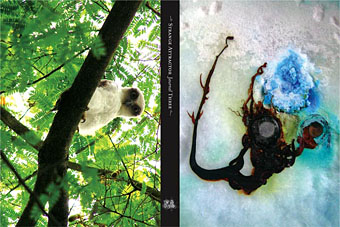
Yes, it’s that magazine again, the perfect thing to feed your head for the new year.
Mark P and SAJ are profiled in the latest Wire.
Ken Hollings rides the world’s subcultural currents mapped by London’s Strange Attractor.
The Wire #275, January 2007
Strange Attractor is well named. There’s really no escaping it. Starting out as a series of live events, it has slowly transmuted into an annual publication, set up an online clearing house for the weird and the wonderful and recently made its first move towards establishing itself as a publishing house. “Strange Attractor celebrates unpopular culture,” runs its mission statement. “We declare war on mediocrity and a pox on the foot soldiers of stupidity. Join us.” Who could possibly resist such a challenge? Sooner or later you have to get involved. (In the interests of full transparency: the writer of this article has taken part in a number of Strange Attractor evenings and is a regular contributor to Strange Attractor Journal.)
With orders for the Strange Attractor publications coming in from all over the world, and mainstream media like The Independent On Sunday praising it for producing “one of the most weirdly beautiful, beautifully weird magazines of the past hundred-odd years” a bigger problem presents itself. How do you celebrate unpopular culture without losing its unpopularity?
“There’s certainly no business plan,” admits Strange Attractor Journal‘s publisher and chief editor, Mark Pilkington. “We’re really making it all up as we go along. I hope that Strange Attractor‘s approach to culture is simultaneously that of the archaeologist, the ethnographer, the anthropologist, the occultist, the showman and the curator.”
It’s a heady mix. The first two issues, both book-sized anthologies running to more than 200 and 400 pages apiece, have presented material ranged across such elusive topics as mind control experiments, mould art, hair sculpture, cargo cults, neglected gods and forgotten waxworks. Such a list limits more than it clarifies, however. Strange Attractor Journal is concerned less with the unexplained than with the unexpected. You never know what it will cover next.
“I think Strange Attractor is refreshing to people in that it manages to straddle several cultural channels while still following its own agenda,” Pilkington admits, “and it’s one not driven by the same obvious memes. But at the same time it’s important that it doesn’t become obscurantist for its own sake—some things are lost for a reason, others will only resurface when the time is right.”
Strange Attractor‘s wayward eclecticism dates back to a series of monthly events begun in the summer of 2001 by Pilkington in collaboration with artist John Lundberg and continuing over the next two years. Staged at London’s Horse Hospital venue, they gave an early indication of the loose network of experimental enterprises that was starting to come into existence, linking outsider artists with cultural anthropologists, textual hackers and practising occultists.
“We’d mix talks, films, music, presentations, each night being themed around a different topic,” Pilkington recalls. “I rather pretentiously called them ‘information happenings’. Subjects ranged from conspiracy theory to theremins, Esperanto to magick, hoaxes, illusions and psychic deceptions: basically anything that interested us and could draw people that we liked or wanted to meet into one place.” Highlights included a live and bloody demonstration of psychic surgery, sci-fi movie themes played on vintage electronic instruments and a live Lovecraft-influenced Chaos Magick ritual with a soundtrack performed “by a band who couldn’t see what was going on.”
After Lundberg enrolled at the National Film and Television School, Pilkington went solo but eventually grew tired of doing regular live events, deciding instead to do something that would last longer: hence the Journal.
The notion of outliving the moment, of being around for more than just a quick cultural fix, is very much a part of SAJ‘s overall look and feel. The first thing you notice is that the front and back cover of each issue is devoid of text or title, which only appears on the book’s spine. If you want to know who the contributors are, you’ll have to look inside.
“For me, it was about giving as much space as possible to striking images and therefore making them stand out on the bookshelf,” Pilkington explains. “I imagined people being aware that something was wrong with the cover but perhaps not being able to put their finger on it.”
The absence of cover copy also binds together the Journal‘s various contributors in the anonymity of a collective endeavour. “We’re lucky enough to live in an age where we can clearly trace the influences of the past on our present,” Pilkington continues, “and it’s not always today’s most celebrated ideas, musicians and writers who will be remembered. This notion of timelessness is very important to what SAJ is and does. I’d like the books to be as irrelevant to a reader 100 years in the future as it would be to someone 100 years in the past. It’s a re-manipulation of the notion of built-in obsolescence.”
The Journal‘s pages teem with old woodcuts, antiquated typefaces and intricate layouts, giving the impression of having been produced in some parallel past: one that runs counter to established tenets of historical development. Having previously worked as a journalist for periodicals as varied as Fortean Times, Bizarre and The Guardian, Mark Pilkington remains keenly aware of what’s going on around him.
“There’s a particularly vibrant, very loose cultural network in London at the moment,” he remarks, “one that incorporates music and sound, ideas and information, visual arts and almost anything else you’d care to imagine. It’s inevitable that these people, places and events all bounce off and influence each other in a kind of subcultural Brownian motion.”
As well as working closely with designer Alison Hutchinson, readying volume three for publication, Pilkington has also been getting Strange Attractor Press up and running. Its first book to date, The Field Guide: The Art, History And Philosophy Of Crop Circle Making by Rob Irving and John Lundberg, is a particularly cerebral blend of art theory, paranormal phenomena, hoaxes and speculations, ruggedly bound and designed to fit snugly inside your knapsack while out exploring the British countryside. Conventional wisdom says it shouldn’t work, but Strange Attractor‘s own particular blend of parlour magic proves that it does.
“I sometimes see myself as a medium,” Mark reveals, “a channel for all the material that has formed Strange Attractor. I’ve been incredibly lucky with the amazing contributions the Journal has attracted so far.”
There’s no escaping it. Strange Attractor really is well named.
Strange Attractor Journal Three, and The Field Guide: The Art, History And Philosophy Of Crop Circle Making by Rob Irving & John Lundberg, are available now.
Previously on { feuilleton }
• Strange Attractor Journal Three
• How to make crop circles
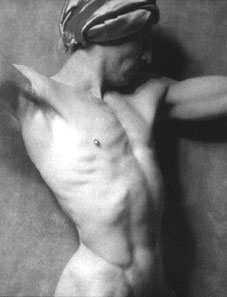
Left: Stowitts photgraphed by Nickolas Muray, 1922.
Hubert Julian Stowitts had a number of careers, including dancer, film actor, painter, designer and metaphysician. As a dancer he worked with Anna Pavlova, who discovered him in California in 1915 and took him on tour around the world. His statuesque figure was used by Rex Ingram for the infernal scenes in The Magician (1926), an adaptation of Somerset Maugham’s rather limp roman-à-clef based on the exploits of Aleister Crowley. The scene with Stowitts as a satyr owed nothing to the book, however, being more inspired by the director’s fondness for the tales of Arthur Machen. Most photos that turn up from this film show Stowitts rather than Paul Wegener who played the sinister alchemist of the title.
Stowitt’s painting developed in the 1930s and included a series of 55 paintings of nude (male) athletes for the 1936 Olympics (see Ewoud Broeksma’s contemporary equivalents at originalolympics.com). Other paintings depicted dance scenes, costume designs, people encountered during travels in the Far East and, in the 1950s, a series of ten Theosophist pictures entitled The Atomic Age Suite.
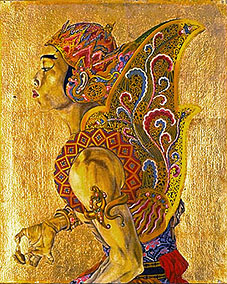
Prince Suwarno in Mahabarata role (1928).
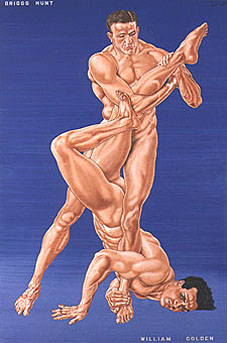
Briggs Hunt and William Golden (1936).
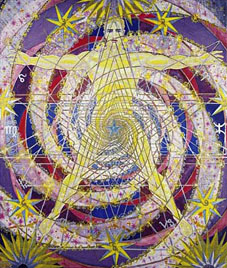
The Crucifixion in Space (1950).
• The Stowitts Museum and Library
• Stowitts at the Queer Arts Resource
Elsewhere on { feuilleton }
• The gay artists archive
Previously on { feuilleton }
• The art of Nicholas Kalmakoff, 1873–1955
In my obsession with all things Orson Welles, his 1936 production of Macbeth holds a special fascination, partly for being my favourite Shakespeare play, and partly for the curiosity of its production—an all-black cast that included genuine Haitian drummers who famously claimed to have drummed a Broadway critic to death after he gave the play a hostile review. The De La Warr Pavilion in Bexhill-on-Sea is hosting an art event based on Welles’ production.
In 1936, whilst the UK was celebrating the new De La Warr Pavilion, and exciting artistic movement was reaching its close in New York—the Harlem Renaissance. A significant event within of this movement was an all-black African American version of Macbeth, presented by The Federal Theatre Project at the New Lafayette Theatre, Harlem and directed by writer and actor Orson Welles. This production became known as ‘Voodoo Macbeth‘.
There are many things that were remarkable about this unique and innovative project. The play was one of the first explorations of a modern and diasporic spin on the Shakespearian tale. It was also the point at which Welles was introduced to John Houseman, which then led to the formation of the Mercury Theatre Company that produced seminal works such as the War of the Worlds and Citizen Kane. Furthermore, the ‘Voodoo Macbeth‘ production displayed visual and aural motifs using lighting, stage design and overlapping sound which became signature elements to Welles’s later film projects.
The essence, spirit, and cross-artform experimentality of ‘Voodoo Macbeth‘ is the basis for a contemporary art, film and performance season at the De La Warr Pavilion and has been named after the production. This unique project looks at the historical and contemporary dialogue that Welles’s work had and still has with performance, film and visual art.
The curatorial concept of the De La Warr Pavilion’s exhibition Voodoo Macbeth focuses on the debate and the ideas around Welles’s unique and defining aesthetic which continues to attract much critical attention. The exhibition suggests that Welles’s approach has informed the work of many contemporary artists working in film today.
Both the historical and contemporary context of Voodoo Macbeth are explored within the exhibition and wider season of events. Original works by Orson Welles are presented alongside those of his contemporaries including Jean Cocteau, Jacques Tourneur and Lee Miller. These artists were working with film and photography during the period of the 1940s onwards and have a shared concern in exploring visual ideas and motifs around the idea of an ‘expansive frame’. As artists, they blurred the boundaries between visual art, theatre, literature and film, to produce lyrical and poetic visual works.
Work by contemporary artists within the exhibition have been selected on the basis that their work embodies the artistic narrative and the spirituality of Welles’s use of light, dark and spatial composition. The exhibition includes work by Phyllis Baldino, Glenn Ligon, Steve McQueen, Mitra Tabrizian and Kara Walker. In this context, Voodoo Macbeth explores how, for artists today, the genre and its relationship to installation practice in performance, film, sound and visual art is an important part of the process. Importantly, they do not mimic the formalist structure of film, painting and sound but endeavour to embed these works with elements of popular culture, critique and humour. Like Welles, who was a masterful story teller, these artists have developed works which take on the character of an intimate 21st century tale. Unlike Welles, these tales are tailor-made, for a gallery audience to explore and enjoy.
Produced by the De La Warr Pavilion in association with Brighton Photo Biennial and curated by associate curator David A Bailey in collaboration with BPB curator 2006 Gilane Tawadros.
The Galleries are open 10am–6pm except on Christmas Eve (closing
at 5pm), Christmas Day (closed all day) and New Year’s Eve (closing at 3pm). Free.Voodoo Macbeth, Oct 7th–Jan 7th.
The Voodoo Macbeth exhibition is a part of the Brighton Photo Biennial, for more details on the BPB please visit their website www.bpb.org.uk, or contact them via the details below.
Biennial Office
University of Brighton
Grand Parade
Brighton BN2 0JYTel: +44 (01)273 643 052
Email: mail@bpb.org.uk